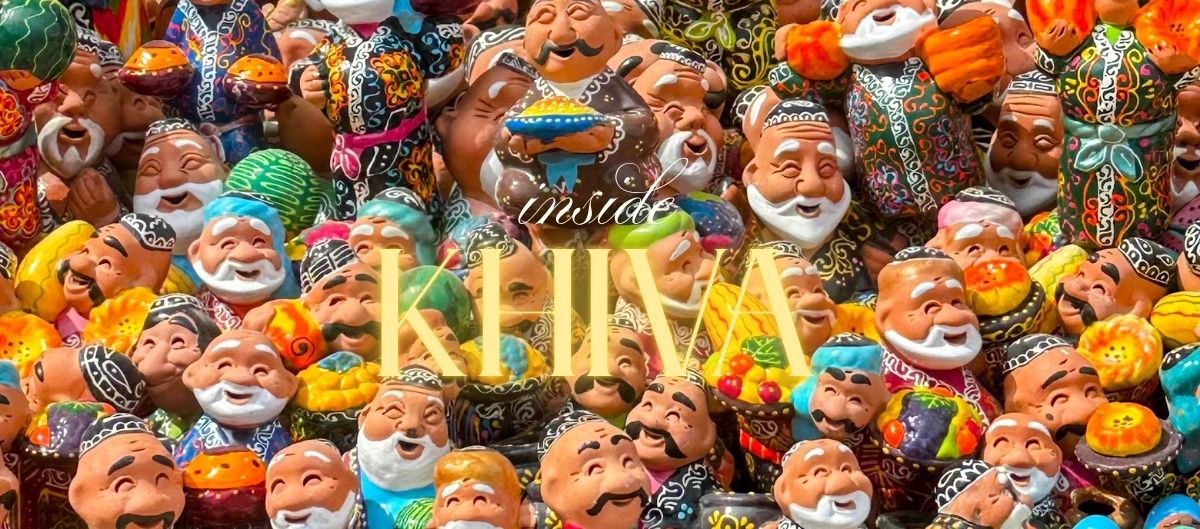Captivating Khiva: An Astonishing Life Inside the City Walls

Khiva’s roots stretch back over 2,500 years, but its golden age began in the 16th century when it became the capital of the Khanate of Khiva. As a major oasis along the Silk Road, it prospered from trade — and infamously, from a large slave market that once operated within its walls.


The real magic of Khiva lies inside Itchan Kala, the old walled city, where more than 50 historic monuments are packed into less than a square kilometer.

It’s like walking through an open-air museum — except it’s still alive, with families living inside, children playing in the alleys, and craftsmen selling their wares. And after a steep and perilous climb, you can stroll on top of this fortress!
Kalta Minor Minaret: Short, wide, and strikingly turquoise, this unfinished minaret is Khiva’s most recognizable landmark.

Kunya Ark: The khans’ fortress, complete with throne room, harem, and beautiful blue-tiled courtyards.


Juma Mosque: Famous for its 200 wooden columns, some dating back to the 10th century — a mystical place of silence and shadow.



Tosh Hovli Palace: “Stone House” in name, but a marvel of tilework, carved wood, and ornate courtyards in reality.




Islam Khoja Minaret: Climb it for the best panoramic view of the city — if you can handle the steep, narrow steps! Open from 5 until 8pm.



Khiva is not just about buildings — it’s a celebration of Khorezm culture, which includes traditional music, dance, embroidery, and carpet weaving. Artisans sell hand-carved wooden columns, glazed tiles, embroidered suzanis, and locally made textiles in open courtyards and along shaded alleyways.
You’ll also encounter locals performing folk songs, playing the dutar (a two-stringed lute), and demonstrating ancient crafts. Many still wear regional robes and headdresses, especially during festivals or weddings.



The food in Khiva reflects the hearty, spice-laced flavors of Khorezm cuisine, distinct from what you’ll find in other parts of Uzbekistan.
Here are a few I enjoyed…
Tukhum-barak: Khorezm-style egg dumplings.

Shivit oshi: A vibrant green noodle dish made with dill, served with meat and yogurt.

Plov: The national rice dish, here cooked with yellow carrots and lamb.

Non: The round, crusty Uzbek bread — always served fresh from the tandoor.

I enjoyed a meal on a rooftop terrace at sunset with magical views over the minarets and clay rooftops.

An unexpected but delightful addition was the (very staged) marriage proposal complete with producer, director, drone views and fireworks!

Honestly, both bride and groom looked less than enthusiastic but I’m told that most marriages are arranged by the couple’s parents. More on this in another post. Really interesting marriage customs in this country…
Staying near Itchan Kala, I stayed at the Asia Hotel just outside the walls, means you can wander its glowing alleys in the evening, when the tour groups leave and the city returns to its timeless calm.

Khiva may not have the cosmopolitan buzz of Samarkand or Bukhara’s grandeur, but it has something equally powerful: atmosphere. It’s a place where time stands still, where every doorway holds a story, and where you’re never far from the footsteps of traders, poets, and rulers who once shaped the fate of empires.
Related Posts
The Quiet Magic of The Turkmen: Nomads of the Steppe
Nestled in Uzbekistan’s remote northwest, Urgench might not be the first name that jumps out …
June 7, 2025Tashkent: A Vibrant Clash of Exotic Culture and Commerce!
The term “Silk Road” evokes images of camel caravans crossing deserts, laden with silk, spices, …
June 5, 2025

Leave A Comment